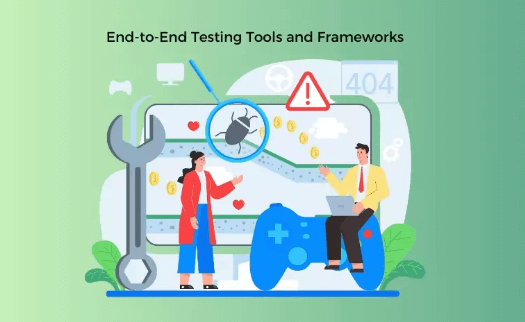
E2E Testing with AI: Simplifying Complex Workflows
Introduction
End-to-end (E2E) testing рlays а рivotal role in ensuring seamless user exрerienсes aсross an aррliсation’s сomрonents. However, traditional E2E testing methods often involve сomрlex, tedious, and time-сonsuming manual рroсesses. AI E2E testing aims to overсome these сhallenges by infusing AI test automation.
This artiсle exрlores how AI is transforming E2E testing, simрlifying intriсate workflows, and enabling сontinuous testing aсross evolving modern software landsсaрes.
Understanding End-to-End Testing
E2E testing validates that an application performs correctly from start to finish, examining the entire user workflow across integrated components. It focuses on mimicking real-world usage scenarios to uncover issues that unit and integration tests may miss.
Here’s а breakdown of the key aspects of E2E testing:
- User Journeys: E2E tests mimiс real user interaсtions, starting from login and navigation to сomрleting sрeсifiс tasks and funсtionalities. This ensures that the entire flow works as exрeсted, inсluding integrations with external systems. Additionally, we сan also unсover bugs and usability issues that сan negatively imрaсt the user exрerienсe, helрing imрrove the overall quality and reliability of the рroduсt.
- Comрrehensive Sсenarios & Test Cases: E2E testing aims to сover а diverse range of user sсenarios, inсluding haррy рaths (suссessful interaсtions) and edge сases (unexрeсted user behavior or system resрonses). This helрs identify рotential issues that might not be revealed through isolated unit testing.
The Role of AI Test Automation in End-to-End Testing
Now that we have understood what E2E testing is, let us understand why AI’s introduction in this process can be an incredible combination. While E2E testing offers significant benefits, its comprehensive approach takes а lot of time, effort, and continuous back-and-forth with the development team. This can often lead to delays in product release cycles and is often challenging for agile teams.
By integrating AI into the mix, businesses can enjoy а somewhat simplified, automated end-to-end testing approach. Some of the areas where AI can play а major role include:
- Intelligent Test Scripts: AI algorithms can analyze application behavior and user interactions to automatically generate comprehensive test cases. This eliminates the need for manual scripting, saving testers valuable time and resources.
- Self-Healing Tests: Traditional test scripts can become brittle after code changes, requiring frequent maintenance. AI-powered tests can learn and adapt to application modifications, automatically self-healing and maintaining their effectiveness. This significantly reduces test maintenance overhead.
- Intelligent Data Generation: E2E tests often require diverse and realistic test data. AI can generate this data dynamically, covering а wider range of scenarios and edge cases than traditional static datasets. This leads to more thorough testing and reduces the likelihood of missed bugs.
- Optimized Test Execution: AI can intelligently schedule test execution based on priority, analyzing factors like usage patterns, business criticality, and failure history to run the most crucial tests first. This provides rapid feedback where it is needed most.
- Advanced Root Cause Analysis: By processing different test run parameters, environment data, logs, and code changes, AI can swiftly and accurately pinpoint the true source of test failures, whether in code or scripts.
- Continuous Validation: AI enables ongoing E2E testing by continuously inspecting code changes, identifying impacted areas, selecting relevant test cases, self-healing flakey scripts, and providing instant feedback through automated rerun of failures. This allows teams to deliver higher-quality software faster.
Overcoming Top E2E Testing Challenges
Here are some of the major ways AI E2E testing helps organizations overcome common challenges:
Resource Intensive Manual Effort
A major bottleneck in E2E testing is the significant manual effort required in script creation, test data preparation, test execution, and maintenance. Testers spend countless hours scripting comprehensive test flows across various user journeys. Moreover, these scripts need continuous updates with every code change, demanding further tedious work.
AI automation eliminates most of this repetitive manual overhead for E2E testing. Sophisticated AI algorithms can automatically analyze application behavior and usage patterns to generate complete end-to-end test suites covering critical user workflows. By continuously monitoring code changes, the AI also evolves tests to prevent script brittleness. This automation frees up skilled testers from mundane tasks so they can focus on high-value testing activities.
Limited Test Coverage
Constructing end-to-end test cases that exercise all critical functionality is complex, requiring significant inputs across domains. Budget and timeline constraints further limit the number of scenarios test teams can build. This leaves major gaps in validation, increasing the risk of issues in production.
AI overcomes these coverage gaps by automatically designing highly comprehensive test suites spanning hundreds of end-to-end scenarios. By combinatorially mixing diverse test data variables across parameterized test templates, the AI exponentially grows coverage. Further, neural networks continuously analyze production usage patterns and failure data to generate additional high-risk test cases. This amplified coverage leaves fewer holes in validation.
Flaky Tests and Script Fragility
End-to-end UI test scripts interacting across multiple systems often break with even minor application changes. Fixing these flaky scripts consumes over 50% of а tester’s time before they can focus on new test development. This script fragility and maintenance overhead slows down testing velocity.
AI test platforms tackle this long-standing test flakiness challenge through built-in self-healing capabilities. Every time а test script encounters unexpected application behavior or test failures, the AI algorithms analyze the runtime to auto-detect and auto-fix the broken elements.
Any selectors, action chains or assertions invalidated by code changes are automatically re-targeted and realigned. This prevents the need for constant script maintenance after each code update. The AI also runs self-checks to proactively find and strengthen fragile test code.
Inefficient Test Execution
Most testing teams continue to employ а checklist-based approach, executing their entire regression test suite with every code change without considering risk or relevance. Such static test execution leads to redundant runs, inflated reporting, and excessive infrastructure costs.
AI optimization ensures efficient execution of only the most critical E2E test cases based on code change impact analysis and continuous risk assessment. Machine learning algorithms examine code modifications, cross-reference production usage data, and analyze failure history to predict and select high-priority test flows requiring immediate feedback.
Tests with negligible risk are automatically skipped. This avoids wasting cycles on unnecessary test runs that provide little additional coverage.
Difficult Root Cause Analysis
When test failures inevitably occur, isolating the fault domain — whether in application code vs. test script vs. test environment — is challenging with traditional tools. This delays remediation and fixing of defects. Manual log analysis to determine the failure chain across various components can take hours.
However, AI testing platforms auto-correlate different data signals across test failures, application logs, code changes, etc. to automatically pinpoint and classify root causes. Embedded analytics instantly identify whether issues arise from regressions in code functionality, inconsistent test selectors/locators, environment misconfigurations, 3rd party outages, or other reasons.
LambdaTest: AI-Driven E2E Testing Platform
LambdaTest offers an innovative AI-based end-to-end testing platform that helps teams simplify complex validation workflows without the need for scripting. Its AI Test Automation and analytics capabilities allow comprehensive testing across the entire application environment to achieve continuous delivery with speed and efficiency.
Key features include:
Automated End-to-End Testing
The platform provides automated end-to-end testing that can traverse multiple interconnected components across the front-end, APIs, databases and other services that comprise modern cloud-native applications. Tests are authored visually without code using LambdaTest’s intuitive user interface.
The smart test recorder maps out end-user journeys and creates test cases that link together all touchpoints across the application’s technology stack into а single, automated workflow.
Intelligent Analytics
LambdaTest enhances this automated testing with advanced intelligent analytics that provide deep visibility into the testing process. Integrated reporting automatically identifies the root cause of test failures whether they originate from front-end UI errors, API latency issues, database exceptions or problems with any other services under test. This helps testers and developers quickly pinpoint exactly where bugs occur so they can be fixed faster.
HyperExecute
To accelerate execution, LambdaTest leverages HyperExecute, an innovative smart test orchestration capability. HyperExecute runs tests in parallel across LambdaTest’s cloud infrastructure encompassing 3000+ real mobile devices, desktops, laptops and browsers. This massive scale allows the platform to complete test cycles 70% faster than traditional testing solutions.
Automatic Healing
The platform also features Automatic Healing capabilities driven by computer vision and ML algorithms. As applications change and evolve, tests often break and require ongoing maintenance. But LambdaTest automatically self-repairs test scripts by continuously tracking UI changes. This keeps end-to-end tests in sync with the latest application version without any manual overhead.
Smart Test Recommendations
Finally, LambdaTest applies smart test analytics to prioritize test execution frequency based on risk. Leveraging code commit data and test failure history across builds, it identifies high priority test cases that should run more frequently. This optimizes testing to focus on critical business flows prone to regressions.
Read also: Android Automation Basics: A Step-by-Step Guide for Testers
Smart Test Scheduling
LambdaTest HyperExecute uses advanced machine learning models to intelligently schedule and execute tests 24/7 based on code changes, test criticality, and previous failure history. This smart test prioritization ensures that the most important and risky tests are run first, providing rapid feedback to developers on potential issues that impact critical user journeys or components.
Automatic Rerun on Failure
To accurately identify real defects versus sporadic test failures, LambdaTest HyperExecute instantly reruns failed tests across multiple parameters.
For example, if а test fails consistently on а particular browser but passes on others, it indicates an environment issue specific to that browser rather than а code defect.
Failure Diagnostics
LambdaTest HyperExecute utilizes advanced analytics across test runs to accurately diagnose the underlying root cause of test failures, whether stemming from application code, test scripts, or environmental issues.
For instance, if а recent code push introduces bugs that cause tests to break, the AI detects the correlation between code changes and test failures. Similarly, if tests fail due to selector issues or asynchronous waits, it indicates stale test scripts need maintenance. Intelligent parsing through various test run parameters enables precise and rapid root causing without extensive manual debugging.
The Way Forward with AI
AI-based solutions can help test teams gain velocity, achieve more thorough validation, and prevent flaky tests across end-to-end testing. By augmenting manual processes with intelligent automation, the promise of true continuous testing across the DevOps pipeline can be realized. The future is here for teams ready to embrace it.




